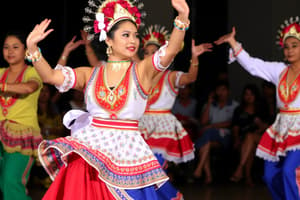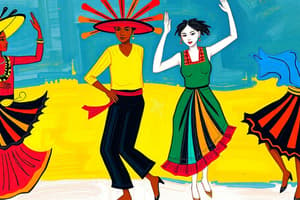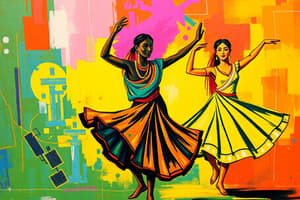Podcast
Questions and Answers
What is the primary characteristic of a hop?
What is the primary characteristic of a hop?
- Bouncing lightly on the ground
- Transferring weight to another foot
- Landing on both feet
- Landing on the same foot (correct)
Which position involves bringing the heels close to touch?
Which position involves bringing the heels close to touch?
- Fifth position
- Second position
- First position (correct)
- Fourth position
What does the term 'pivot' refer to in movement?
What does the term 'pivot' refer to in movement?
- Jumping with both feet
- Sliding foot smoothly along the floor
- Turning on a fixed point (correct)
- Bringing a foot forcibly down
In which position are the arms raised below shoulder level?
In which position are the arms raised below shoulder level?
What defines a jump in dance movements?
What defines a jump in dance movements?
Which action is characterized by transferring weight and advancing by raising one foot?
Which action is characterized by transferring weight and advancing by raising one foot?
Which movement involves gliding the foot smoothly along the floor?
Which movement involves gliding the foot smoothly along the floor?
In the Fifth position, how are the arms arranged?
In the Fifth position, how are the arms arranged?
What is the Visayan term for moving the hand from the wrist in either a clockwise or counterclockwise direction?
What is the Visayan term for moving the hand from the wrist in either a clockwise or counterclockwise direction?
Which term describes partners bowing to each other or to the audience with feet together?
Which term describes partners bowing to each other or to the audience with feet together?
What dance term refers to the action of swinging one arm downward-upward, simulating a scooping motion?
What dance term refers to the action of swinging one arm downward-upward, simulating a scooping motion?
Which dance term means partners turn once around, with elbows almost touching, using a walking step?
Which dance term means partners turn once around, with elbows almost touching, using a walking step?
What is the meaning of the term 'Patay' in dance?
What is the meaning of the term 'Patay' in dance?
Which term is used to describe the position where arms are side horizontal with elbows bent at right angles?
Which term is used to describe the position where arms are side horizontal with elbows bent at right angles?
What does the dance term 'Panadyak' refer to?
What does the dance term 'Panadyak' refer to?
Which term describes a movement where both dancers advance forward and pass each other’s sides?
Which term describes a movement where both dancers advance forward and pass each other’s sides?
What is the primary characteristic of folk dance?
What is the primary characteristic of folk dance?
Which of the following dances is categorized under Cordillera Dances?
Which of the following dances is categorized under Cordillera Dances?
What do Muslim Dances primarily express?
What do Muslim Dances primarily express?
What is the purpose of Rural Dances in the Philippines?
What is the purpose of Rural Dances in the Philippines?
Which of the following is NOT a classification of Philippine Folk Dances?
Which of the following is NOT a classification of Philippine Folk Dances?
What reflects the intricacy of Tribal Dances in the Philippines?
What reflects the intricacy of Tribal Dances in the Philippines?
Which statement about Spanish Influenced Dances is correct?
Which statement about Spanish Influenced Dances is correct?
What is a defining element of Folk Dance?
What is a defining element of Folk Dance?
In what way do the movements of Islamic dances differ from other folk dances?
In what way do the movements of Islamic dances differ from other folk dances?
The 'Jota' and 'Habanera' are examples of which category of dances?
The 'Jota' and 'Habanera' are examples of which category of dances?
Flashcards are hidden until you start studying
Study Notes
What is Dance?
- Dance serves as a form of self-expression through rhythmic movement.
What is Folk Dance?
- Considered the oldest dance form and an early means of communication.
- Represents traditional dance specific to a country, evolving naturally with everyday activities.
- Passed down through generations, showcasing unique movements that vary by region.
Major Classifications of Philippine Folk Dances
- Cordillera Dances: Originating from tribes such as Bontoc, Ifugao, Benguet, Apayao, and Kalinga, reflect rituals celebrating daily life such as harvest and health.
- Spanish Influenced Dances: Created by Filipino aristocrats adapting European styles, including jotas, fandanggos, mazurkas, and waltzes, often performed to rondalla music.
- Muslim Dances: Influenced by Malay and Middle Eastern cultures, emphasizing mysticism and beauty through intricate hand movements and elaborate costumes.
- Tribal Dances: Known as ethnic dances, showcase the craftsmanship of various ethnic minority groups in the Philippines, reflecting beliefs in spirits and nature.
- Rural Dances: Highlight festivities and communal life, performed during fiestas to honor patron saints or celebrate harvests, typically using indigenous materials.
Examples of Dances by Classification
- Cordillera: "Pattong" (Bontoc) and "Banga" (Kalinga).
- Spanish Influenced: "Jota" and "Habanera".
- Muslim: "Singkil" (Maranao) and "Pangalay" (Tausug).
- Tribal: "Madal Tahaw" (T’boli) and "Bangkakaw" (Manobo).
- Rural: "Maglalatik", "Sayaw sa bangko", and "Oasioas".
Common Dance Terms in Folk Dancing
-
Arms and Hands:
- "Hayon-hayon": Positioning forearms around the waist.
- "Kumintang": Circular hand movement from the wrist.
- "Salok": Scooping motion with arms.
- "Saludo": Bowing gesture to partners or audience.
-
Feet Movements:
- "Panadyak": Stamping foot forward and closing to the other foot.
- "Leap": Taking flight from one foot and landing on the other.
- "Pivot": Turning on a fixed point with the foot.
- "Stamp": Bringing the foot down forcefully.
Fundamental Positions in Folk Dance
- First Position: Arms circle in front of the chest; feet touch at heels.
- Second Position: Arms open sideward at shoulder level; feet apart.
- Third Position: One arm overhead; one foot's heel touches the other foot’s instep.
- Fourth Position: One arm in front of the chest; other arm overhead; one foot in front of the other.
- Fifth Position: Both arms raised overhead gracefully; one foot's heel touches the toe of the other foot.
Studying That Suits You
Use AI to generate personalized quizzes and flashcards to suit your learning preferences.




